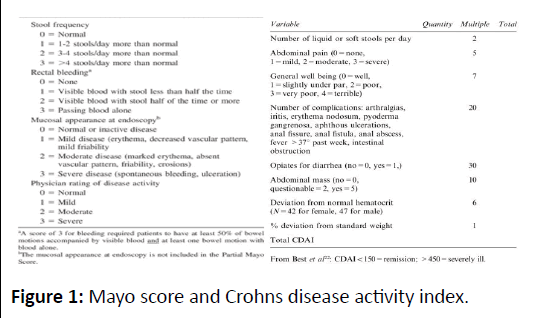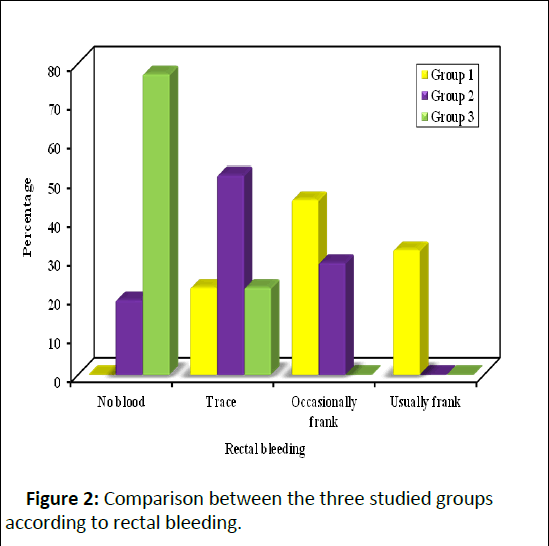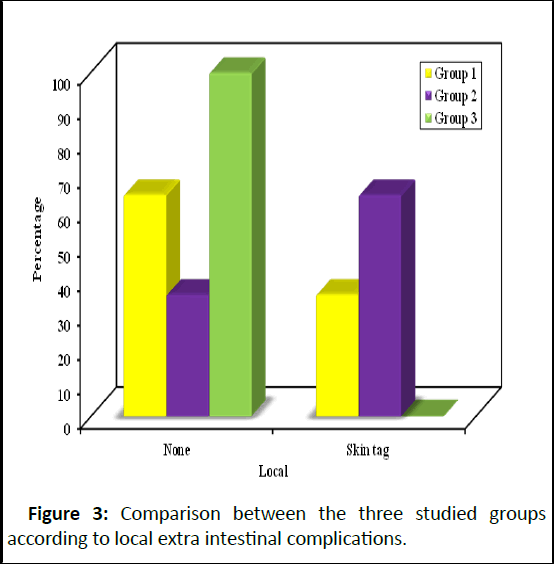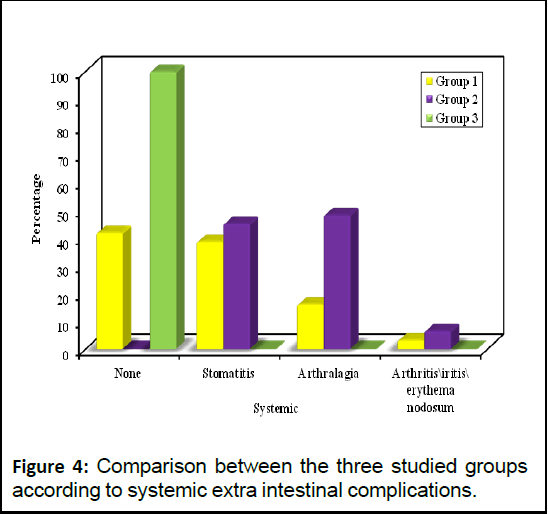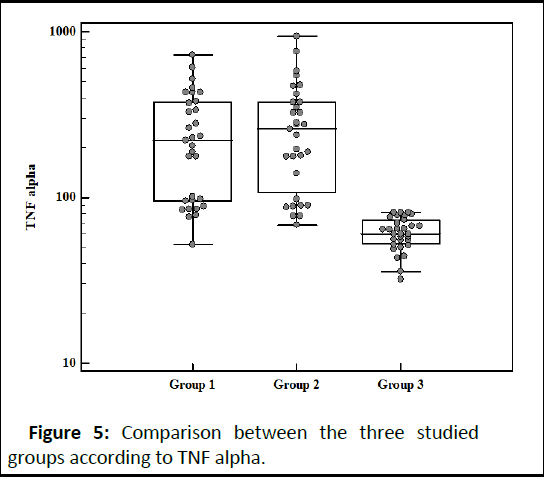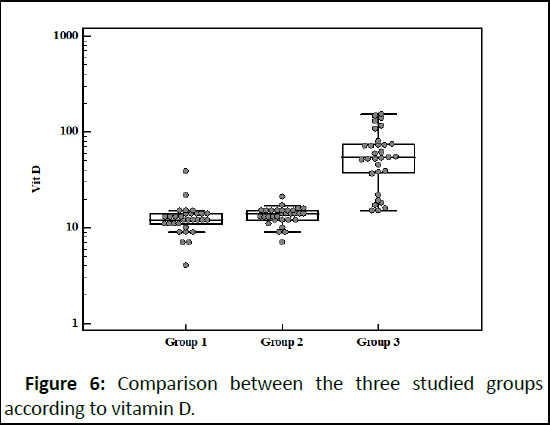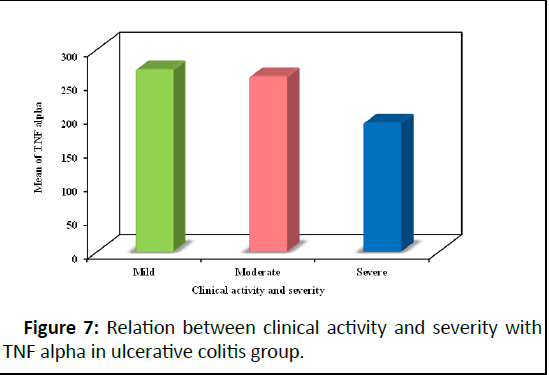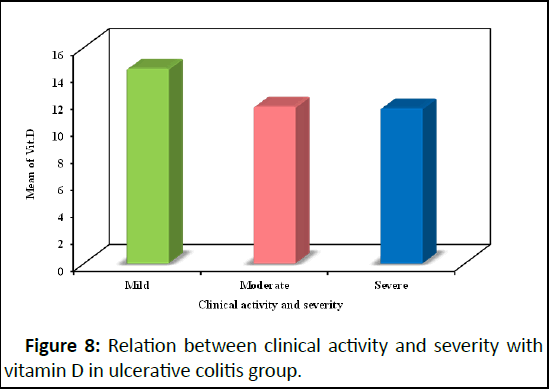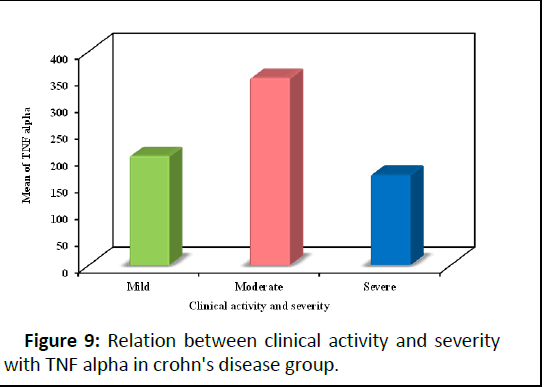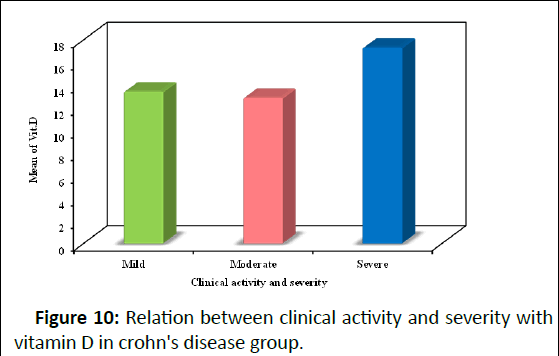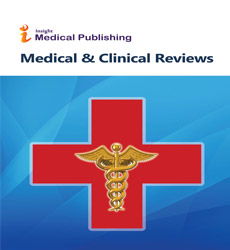Role of Vitamin D in Activity and Severity of Inflammatory Bowel Disease in Egyptian Patients
Abdel Naser Abdel Atty Gadallah, Ashraf Gharieb Dala, Eman Abdel Fattah Badr, Mohamed Abdelmonaem Abdelmonsef*, Mohamed Ebrahem Shabaan and Hany Abdelbary Abdelaziz Elbasuony
Published Date: 2025-01-25Abdel Naser Abdel Atty Gadallah1, Ashraf Gharieb Dala1, Eman Abdel Fattah Badr2, Mohamed Abdelmonaem Abdelmonsef1*, Mohamed Ebrahem Shabaan3 and Hany Abdelbary Abdelaziz Elbasuony1
1Department of Internal Medicine, Menoufia University, Shebeen Elkom, Menoufia, Egypt
2Department of Biochemistry and Molecular Biology, Menoufia University, Shebeen Elkom, Menoufia, Egypt
3Department of Pathology, Menoufia University, Shebeen Elkom, Menoufia, Egypt
*Corresponding Author:
- Abdel Naser Abdel Atty Gadallah
Department of Internal Medicine, Menoufia University, Shebeen Elkom, Menoufia, Egypt
E-mail: M7md_abdelmonaem@yahoo.com
Received date: October 10, 2023, Manuscript No. IPMCR-23-18082; Editor assigned date: October 12, 2023, PreQC No. IPMCR-23-18082 (PQ); Reviewed date: October 26, 2023, QC No. IPMCR-23-18082; Revised date: January 18, 2025, Manuscript No. IPMCR-23-18082 (R); Published date: January 25, 2025, DOI: 10.36648/2471-299X.11.1.77
Citation: Gadallah ANAA, Dala AG, Badr EAF, Abdelmonsef MA, Shabaan ME, et al. ( 2025) Role of Vitamin D in Activity and Severity of InflammatoryBowel Disease in Egyptian Patients. Med Clin Rev Vol:11 No:1
Abstract
Background and aim: Inflammatory Bowel Diseases (IBD) Comprise Ulcerative Colitis (UC) and Crohn’s Disease (CD), which are chronical and recurrent disorders that affect the gastrointestinal tract. Diagnosing IBD requires a combination of clinical findings, inflammatory laboratory markers, imaging findings, and endoscopic biopsies. Vitamin D deficiency is generally higher in patients with CD than UC and usually higher than that of the general population. This study aims to evaluate the role of vitamin D in activity and severity of inflammatory bowel disease in Egyptian patients.
Methods: Our study was conducted on 62 IBD (UC and CD) naïve patients and 31 normal persons from the GI endoscopy unit of internal medicine department, Menoufia university hospital during the period between November 2021 and June 2023. All participants were subjected to history taking, clinical examination and routine lab investigations. Serum vitamin D level was also measured.
Results: This study showed highly significant difference between studied groups as regard serum vitamin D level with low level of vitamin D in IBD patients. Vitamin D is associated with different IBD activity status.
Conclusion: Vitamin D is associated with different IBD activity status and its deficiency is highly prevalent among IBD patients.
Keywords
IBD; Ulcerative colitis; Crohn's disease; Vitamin D
Abbreviations
IBD: Inflammatory Bowel Disease; UC: Ulcerative Colitis; CD: Crohn's Disease; GI: Gastrointestinal; CBC: Complete Blood Count; AST: Aspartate Aminotransferase; ALT: Alanine Aminotransferase; ESR: Erythrocyte Sedimentation Rate; CRP: C-Reactive Protein; CDAI: Crohn's Disease Activity Index; ELISA: Enzyme-Linked Immunosorbent Assay; PLT: Platelets; TLC: Total Leukocyte Count; HB: Hemoglobin
Introduction
Inflammatory Bowel Diseases (IBD) comprise Ulcerative Colitis (UC) and Crohn’s Disease (CD), which are chronical and recurrent disorders that affect the gastrointestinal tract. The etiology of IBD is not yet fully understood, but there are reports of a complex relationship between genetic, immunological and environmental factors, as well as gut microbiota [1-4].
Diagnosing IBD requires a combination of clinical findings, inflammatory laboratory markers, imaging findings, and endoscopic biopsies [5].
Many studies have evaluated the prevalence of vitamin D deficiency and insufficiency in people with IBD. Vitamin D deficiency is generally higher in patients with CD than UC and usually higher than that of the general population [6].
Various studies reported the role of vitamin D in IBD. Vitamin D deficiency may lead to a reduction in bacterial clearance in the colon. This vitamin changes the immune responses by influencing macrophages and T lymphocytes, hence avoiding excessive immune responses, and also repairs the intestinal mucosal barrier [7].
We conducted this study to evaluate the role of vitamin D in activity and severity of inflammatory bowel disease in Egyptian patients.
Materials and Methods
Patients and methods
This study was approved by the local institutional ethical committee of Menoufia University, Menoufia University and the participants gave an informed consent. The study was conducted on 62 IBD (UC and CD) naïve patients and 31 normal persons from the GI endoscopy unit of internal medicine department, Menoufia University hospital during the period between November 2021 and June 2023.
Participants were classified into three groups:
- Group 1: Ulcerative colitis patients including 31 participants.
- Group 2: Crohn's disease patients including 31 participants.
- Group 3: Control group resemble normal persons including 31 participants.
Participants included in the study aged 18 years or older and were naïve IBD patients with no previous treatment.
Exclusion criteria showed age younger than 18 years and patients on IBD medications.
Participants were subjected to the following: History taking (age and gender), complete clinical examination including (temperature, blood pressure measurement, pulse, and body mass index), routine Laboratory investigations including (CBC, AST, ALT, albumin, urea and creatinine), ESR, CRP, fecal calprotectin, serum vitamin D level and serum TNF alpha level.
Ileocolonic biopsies were collected from patients undergoing colonoscopy for histopathological evaluation.
Mayo score and Crohn’s Disease Activity Index (CDAI) were used to assess disease activity in patients with ulcerative colitis and Crohn's disease respectively.
Demographic, clinical and laboratory data of the cases were given in below Figure 1.
Figure 1: Mayo score and Crohns disease activity index.
Details about tools were used in this study
Colonscope: Company manufacturing (Olympus Corporation), country (Japan), city (Tokyo).
Human vitamin D3 ELISA kits: company manufacturing (SunRed Biotechnology Company), country (China), and city (Shanghai).
Human TNF alpha ELISA kits: company manufacturing (SunRed Biotechnology Company), country (China), and city (Shanghai).
Statistical analysis
Data entry, coding, and analysis were conducted using SPSS (22), IBM Corp. Released 2015. IBM SPSS Statistics for Windows, Version 23.0 Armonk, NY: IBM Corp. USA. Description of quantitative variables was in the form of mean and Standard Deviation (mean ± SD), description of qualitative variables was by frequency and percentage, chi square test was used to assess the relationship between two qualitative groups, t-test was to assess the relationship between two quantitative groups. P value ≤ 0.05 was set to be statistically significant.
Results
This study showed highly significant difference between studied groups as regard serum vitamin D level with low level of vitamin D in IBD patients. Vitamin D is associated with different IBD activity status.
Our study showed highly significant difference between studied groups regarding ESR and CRP with p value <0.001 and <0.001 respectively (Table 1).
|
|
Group 1 |
Group 2 |
Group 3 |
F |
P |
Sig. bet. grps. |
||
|
1 vs. 2 |
1 vs. 3 |
2 vs. 3 |
||||||
|
ESR (mms) |
||||||||
|
Min.-Max. |
40.0-80.0 |
44.0-87.0 |
5.0-9.0 |
428.917*
|
<0.001*
|
0.94
|
<0.001*
|
<0.001*
|
|
Mean ± SD. |
68.52 ± 10.92 |
67.71 ± 11.19 |
7.16 ± 1.19 |
|||||
|
Median (IQR) |
68.0 (59.0-76.0) |
68.0 (59.50-76.0) |
7.0 (6.0-8.0) |
|||||
|
CRP (IU/ml) |
||||||||
|
Min.-Max. |
30.0-70.0 |
30.0-65.0 |
2.0-5.0 |
394.511*
|
<0.001*
|
0.611
|
<0.001*
|
<0.001*
|
|
Mean ± SD. |
44.52 ± 7.81 |
46.13 ± 8.53 |
3.97 ± 0.84 |
|||||
|
Median (IQR) |
45.0 (39.0-49.0) |
45.0 (41.0-53.50) |
4.0 (3.0-5.0) |
|||||
|
Note: IQR: Inter Quartile Range. |
||||||||
Table 1: Comparison between the three studied groups according to ESR and CRP.
In the current study there is no significant difference between ulcerative colitis group and Crohn's disease group as regard ESR and CRP with P value 0.940 and 0.611 respectively (Table 1).
This study showed highly significant difference between the 3 studied groups as regard fecal calprotectin with (P value <0.001) (Table 2).
| Fecal calprotectin (microgram/milligram) | Group 1 (n=31) | Group 2 (n=31) |
Group 3 (n=31) |
H | p | Sig. bet. grps. | ||
|---|---|---|---|---|---|---|---|---|
| 1 vs. 2 | 1 vs. 3 | 2 vs. 3 | ||||||
| Min.-Max. | 260.0-80.0 | 280.0-870.0 | 30.0-75.0 | 61.425* | <0.001* | 0.836 | <0.001* | <0.001* |
| Mean ± SD. | 463.8 ± 153.9 | 479.3 ± 169.8 | 54.29 ± 13.68 | |||||
| Median (IQR) | 453.0 (350.5-538.0) | 453.0 (350.5-611.5) | 55.0 (45.0-64.0) | |||||
| Note: IQR: Inter quartile range SD: Standard deviation H: H for Kruskal Wallis test, pairwise comparison bet. Each 2 groups was done using Post Hoc Test (Dunn's for multiple comparisons test) p: p value for comparing between the studied groups *: Statistically significant at p ≤ 0.05 Group 1: ulcerative colitis group, group 2: Crohns disease group, group 3: control group, n: number |
||||||||
Table 2: Comparison between the three studied groups according to fecal calprotectin.
The present study showed highly significant difference between the 3 studied groups as regard serum vitamin D level with (P value <0.001) (Table 3).
| Vitamin D level (ng/ml) | Group 1 (n=31) |
Group 2 (n=31) |
Group 3 (n=31) |
H | p | Sig. bet. grps. | ||
|---|---|---|---|---|---|---|---|---|
| 1 vs. 2 | 1 vs. 3 | 2 vs. 3 | ||||||
| Min.-Max. | 4.0-39.0 | 7.0-21.0 | 15.0-153.0 | 58.582* | <0.001* | 0.163 | <0.001* | <0.001* |
| Mean ± SD. | 12.87 ± 5.79 | 13.48 ± 2.64 | 63.03 ± 40.23 | |||||
| Median (IQR) | 12.0 (11.0-14.0) | 14.0 (12.0-15.0) | 54.0 (37.5-73.5) | |||||
| Note: IQR: Inter quartile range SD: Standard deviation H: H for Kruskal Wallis test, Pairwise comparison bet. each 2 groups was done using Post Hoc Test (Dunn's for multiple comparisons test) p: p value for comparing between the studied groups *: Statistically significant at p ≤ 0.05 Group 1: ulcerative colitis group, group 2: Crohns disease group, group 3: control group, n: number |
||||||||
Table 3: Comparison between the three studied groups according to serum vitamin D level.
In the current study there is highly significant difference between the 3 studied groups as regard serum TNF alpha level with (P value <0.001) (Tables 4-6).
| TNF alpha level (pg/ml) | Group 1 (n=31) |
Group 2 (n=31) |
Group 3 (n=31) |
H | p | Sig. bet. grps. | ||
|---|---|---|---|---|---|---|---|---|
| 1 vs. 2 | 1 vs. 3 | 2 vs. 3 | ||||||
| Min.-Max. | 52.0-723.0 | 68.0-940.0 | 32.0-81.0 | 54.601* | <0.001* | 0.665 | <0.001* | <0.001* |
| Mean ± SD. | 256.1 ± 176.4 | 290.5 ± 210.0 | 61.55 ± 13.30 | |||||
| Median (IQR) | 222.0 (95.5-375.0) | 261.0 (119.0-376.5) | 60.0 (53.5-71.5) | |||||
| Note: IQR: Inter quartile range SD: Standard deviation H: H for Kruskal Wallis test, Pairwise comparison bet. each 2 groups was done using Post Hoc Test (Dunn's for multiple comparisons test) p: p value for comparing between the studied groups. *: Statistically significant at p ≤ 0.05 TNF: tumor necrosis factor Group 1: ulcerative colitis group, group 2: Crohns disease group, group 3: control group, n: number |
||||||||
Table 4: Comparison between the three studied groups according to serum TNF alpha level.
|
|
Clinical activity and severity |
H
|
p
|
|||
|
Mild |
Moderate |
Severe |
||||
|
TNF alpha level (pg/mg) |
||||||
|
Min.-Max. |
52.0-613.0 |
76.0-723.0 |
78.0-371.0 |
0.722
|
0.697
|
|
|
Mean ± SD. |
270.6 ± 182.2 |
260.2 ± 188.7 |
191.5 ± 135.8 |
|||
|
Median |
246 |
206 |
158.5 |
|||
|
Vitamin D level (ng/mg) |
||||||
|
Min.-Max. |
7.0-39.0 |
4.0-15.0 |
10.0-13.0 |
0.885
|
0.642
|
|
|
Mean ± SD. |
14.43 ± 7.95 |
11.62 ± 3.12 |
11.50 ± 1.29 |
|||
|
Median |
12 |
13 |
11.5 |
|||
|
Note: SD: Standard deviation |
||||||
Table 5: Relation between clinical activity and severity with serum TNF alpha level and serum vitamin D level in ulcerative colitis group.
|
|
Clinical activity and severity |
H
|
p
|
||
|
Mild |
Moderate |
Severe |
|||
|
TNF alpha level (pg/mg) |
|||||
|
Min.-Max. |
68.0-377.0 |
77.0-940.0 |
90.0-238.0 |
3.322 |
0.19 |
|
Mean ± SD. |
204.3 ± 116.6 |
350.4 ± 238.5 |
169.3 ± 74.57 |
||
|
Median |
195 |
323 |
180 |
||
|
Vitamin D level (ng/mg) |
|||||
|
Min.-Max. |
11.0-16.0 |
7.0-17.0 |
15.0-21.0 |
5.829
|
0.054
|
|
Mean ± SD. |
13.44 ± 1.67 |
12.89 ± 2.54 |
17.33 ± 3.21 |
||
|
Median |
13 |
14 |
16 |
||
|
Note: SD: Standard deviation |
|||||
Table 6: Relation between clinical activity and severity with serum TNF alpha level and serum vitamin D level in Crohns disease group.
Our study showed no significant difference between studied groups regarding sociodemographic data including age and gender with p value (0.842) (0.827) respectively (Tables 7 and 8).
|
|
Group 1 (n=31) |
Group 2 (n=31) |
Group 3 (n=31) |
Test of sig. |
P |
|||
|
|
No. |
% |
No. |
% |
No. |
% |
||
|
Gender |
||||||||
|
Male |
14 |
45.2 |
16 |
51.6 |
20 |
64.5 |
X2= |
0.842 |
|
Female |
17 |
54.8 |
15 |
48.4 |
11 |
35.5 |
||
|
Age (years) |
||||||||
|
Min.-Max. |
18.0-55.0 |
19.0-50.0 |
20.0-54.0 |
F= |
0.827
|
|||
|
Mean ± SD. |
34.84 ± 10.67 |
33.35 ± 9.34 |
33.71 ± 9.64 |
|||||
|
Median (IQR) |
36.0 (26.50-42.0) |
35.0 (26.50-39.50) |
35.0 (26.50-40.50) |
|||||
|
Residence |
||||||||
|
Urban |
15 |
48.4 |
17 |
54.8 |
12 |
38.7 |
X2= |
0.958 |
|
Rural |
16 |
51.6 |
14 |
45,2 |
19 |
61.3 |
||
|
Special habits (smoking) |
||||||||
|
Yes |
10 |
32.3 |
15 |
48.4 |
8 |
25.8 |
X2= |
0.402 |
|
No |
21 |
67.7 |
16 |
51.6 |
23 |
74.2 |
||
|
Consanguinity |
||||||||
|
Yes |
5 |
16.1 |
7 |
22.6 |
2 |
6.5 |
X2= |
MCp= |
|
No |
26 |
83.9 |
24 |
77.4 |
29 |
93.5 |
||
|
Family history |
||||||||
|
Yes |
4 |
12.9 |
6 |
19.4 |
2 |
6.5 |
X2= |
0.091 |
|
No |
27 |
87.1 |
25 |
80 |
29 |
93.5 |
||
|
Note: IQR: Inter quartile range |
||||||||
Table 7: Comparison between the three studied groups according to demographic data.
|
|
Group 1 |
Group 2 |
Group 3 |
F |
P |
|
|
Systolic blood pressure (mmHg) |
||||||
|
Min.-Max. |
|
93.0-156.0 |
90.0-160.0 |
90.0-145.0 |
0.005
|
0.995
|
|
Mean ± SD. |
|
110.8 ± 16.16 |
116.9 ± 19.0 |
117.2 ± 18.76 |
||
|
Median (IQR) |
|
119.0 (105.0-124.50) |
119.0 (99.50-126.50) |
119.0 (100.0-126.0) |
||
|
Diastolic blood pressure (mmHg) |
||||||
|
Min.-Max. |
|
60.0-950.0 |
60.0-100.0 |
60.0-90.0 |
0.052
|
0.95
|
|
Mean ± SD. |
|
73.35 ± 9.67 |
73.84 ± 10.20 |
74.16 ± 9.90 |
||
|
Median (IQR) |
|
74.0 (67.50-80.0) |
75.0 (65.0-80.0) |
75.0 (67.50-80.0) |
||
|
Temperature(°C) |
||||||
|
Min.-Max. |
37.40-39.0 |
|
37.60-40.0 |
37.0-38.0 |
1.311
|
0.275
|
|
Mean ± SD. |
38.16 ± 0.49 |
|
38.18 ± 0.52 |
36.87 ± 0.31 |
||
|
Median (IQR) |
38.0 (37.85-38.55) |
|
38.0 (37.80-38.65) |
37.90 (37.70-38.40) |
||
|
Pulse (bpm) |
||||||
|
Min.-Max. |
80.0-115.0 |
|
77.0-112.0 |
79.0-110.0 |
2.019
|
0.139
|
|
Mean ± SD. |
96.74 ± 9.06 |
|
94.94 ± 8.40 |
92.26 ± 9.04 |
||
|
Median (IQR) |
99.0 (89.0-100.0) |
|
95.0 (89.0-99.0) |
90.0 (88.0-99.0) |
||
|
Note: IQR: Inter quartile range |
||||||
Table 8: Comparison between the three studied groups according to vital signs.
Also, there was no significant difference in this study as regard body mass index with p value (0.712) (Table 9).
|
|
Group 1 |
Group 2 |
Group 3 |
F |
P |
|---|---|---|---|---|---|
|
Weight (kg) |
|||||
|
Min.-Max. |
60.0-93.0 |
67.0-100.0 |
60.0-107.0 |
0.399
|
0.672
|
|
Mean ± SD. |
76.48 ± 8.46 |
78.58 ± 9.94 |
77.90 ± 9.85 |
||
|
Median (IQR) |
77.0 (71.0-83.0) |
78.0 (71.50-87.50) |
77.0 (71.0-86.50) |
||
|
Height (cm) |
|||||
|
Min.-Max. |
162.0-183.0 |
166.0-187.0 |
160.0-185.0 |
0.056
|
0.946
|
|
Mean ± SD. |
174.1 ± 5.32 |
174.5 ± 5.13 |
174.2 ± 5.09 |
||
|
Median (IQR) |
173.0 (169.0-180.0) |
174.0 (170.0-180.0) |
173.0 (170.0-180.0) |
||
|
Body mass index (kg/m²) |
|||||
|
Min.Max. |
19.0-31.20 |
20.30-30.50 |
22.30-31.80 |
0.341
|
0.712
|
|
Mean ± SD. |
25.25 ± 3.11 |
25.84 ± 2.93 |
25.71 ± 2.94 |
||
|
Median (IQR) |
25.60 (23.15-27.50) |
25.0 (23.70-28.0) |
24.80 (23.70-28.0) |
||
|
Note: IQR: Inter quartile range |
|||||
Table 9: Comparison between the three studied groups according to anthropometric measurement.
The present study showed highly significant difference between studied groups regarding Number of bowel motions per 24 h with p value <0.001 (Table 10).
| Number of bowel motions per 24 h | Group 1 (n=31) |
Group 2 (n=31) |
Group 3 (n=31) |
H | p | Sig. bet. grps. | ||
|---|---|---|---|---|---|---|---|---|
| 1 vs. 2 | 1 vs. 3 | 2 vs. 3 | ||||||
| Min.-Max. | 4.0-12.0 | 3.0-8.0 | 4.0-7.0 | 13.140* | <0.001* | <0.001* | 0.009* | 0.386 |
| Mean ± SD. | 8.03 ± 2,3 | 5.23 ± 1.23 | 5.52 ± 1.09 | |||||
| Median (IQR) | 7.0 (5.50-7.50) | 5.0 (4.0-6.0) | 6.0 (5.0-6.0) | |||||
| Note: IQR: Inter quartile range SD: Standard deviation H: H for Kruskal Wallis test, Pairwise comparison bet. each 2 groups was done using Post Hoc Test (Dunn's for multiple comparisons test) p: p value for comparing between the studied groups *: Statistically significant at p ≤ 0.05 Group 1: Ulcerative colitis patients, Group 2: Crohn's disease patients, Group 3: Control, n: number |
||||||||
Table 10: Comparison between the three studied groups according to number of bowel motions per 24 h.
Also there was highly significant difference between studied groups regarding presence of rectal bleeding with p value <0.001 (Tables 11-13 and Figures 2-5).
| Rectal bleeding | Group 1 (n=31) |
Group 2 (n=31) |
Group 3 (n=31) |
X2 | p | Sig. bet. grps. | |||||
|---|---|---|---|---|---|---|---|---|---|---|---|
| No. | % | No. | % | No. | % | 1 vs. 2 | 1 vs. 3 | 2 vs. 3 | |||
| No blood | 0 | 0 | 6 | 19.4 | 24 | 77.4 | 70.639* | <0.001* | MCp <0.001* |
<0.001* | MCp <0.001* |
| Trace | 7 | 22.6 | 16 | 51.6 | 7 | 22.6 | |||||
| Occasionally frank | 14 | 45.2 | 9 | 29 | 0 | 0 | |||||
| Usually frank | 10 | 32.3 | 0 | 0 | 0 | 0 | |||||
| Note: X2: Chi square test MC: Monte Carlo p: p value for comparing between the studied groups *: Statistically significant at p ≤ 0.05 Group 1: Ulcerative colitis patients, Group 2: Crohn's disease patients, Group 3: Control, n: number |
|||||||||||
Table 11: Comparison between the three studied groups according to rectal bleeding.
| General wellbeing (average daily rates in the past 7 days) | Group 1 (n=31) |
Group 2 (n=31) |
Group 3 (n=31) |
X2 | p | Sig. bet. grps. | |||||
|---|---|---|---|---|---|---|---|---|---|---|---|
| 1 vs. 2 | 1 vs. 3 | 2 vs. 3 | |||||||||
| No. | % | No. | % | No. | % | ||||||
| Generally well | 7 | 22.6 | 11 | 35.5 | 31 | 100 | 49.102* | <0.001* | 0.065 | <0.001* | MCp <0.001* |
| Slightly under par | 12 | 38.7 | 16 | 51.6 | 0 | 0 | |||||
| Poor | 12 | 38.7 | 4 | 12.9 | 0 | 0 | |||||
| Note: X2: Chi square test MC: Monte Carlo p: p value for comparing between the studied groups *: Statistically significant at p ≤ 0.05 Group 1: Ulcerative colitis patients, Group 2: Crohn's disease patients, Group 3: Control, n: number |
|||||||||||
Table 12: Comparison between the three studied groups according to general wellbeing.
|
Extra intestinal Manifestations and complications
|
Group 1 (n=31) |
Group 2 (n=31) |
Group 3 (n=31) |
X2
|
P
|
Sig. bet. grps. |
|||||
|---|---|---|---|---|---|---|---|---|---|---|---|
|
1 vs. 2 |
1 vs. 3 |
2 vs. 3 |
|||||||||
|
No. |
% |
No. |
% |
No. |
% |
||||||
|
Local |
|||||||||||
|
None |
20 |
64.5 |
11 |
35.5 |
31 |
100 |
29.129* |
<0.001* |
0.022* |
<0.001* |
<0.001* |
|
Skin tag |
11 |
35.5 |
20 |
64.5 |
0 |
0 |
|||||
|
Systemic |
|||||||||||
|
None |
13 |
41.9 |
0 |
0 |
31 |
100 |
77.527*
|
MCp |
MCp <0.001*
|
MCp <0.001*
|
MCp <0.001* |
|
Stomatitis |
12 |
38.7 |
14 |
45.2 |
0 |
0 |
|||||
|
Arthralagia |
5 |
16.1 |
15 |
48.4 |
0 |
0 |
|||||
|
Arthritis\iritis\erythema nodosum |
1 |
3.2 |
2 |
6.5 |
0 |
0 |
|||||
|
Note: c2: Chi square test |
|||||||||||
Table 13: Comparison between the three studied groups according to extra intestinal Manifestations and complications.
Figure 2: Comparison between the three studied groups according to rectal bleeding.
Figure 3: Comparison between the three studied groups according to local extra intestinal complications.
Figure 4: Comparison between the three studied groups according to systemic extra intestinal complications.
This study showed highly significant difference between studied groups as regard PLT, TLC and HB with (P value <0.001) (Tables 14-16).
Figure 5: Comparison between the three studied groups according to TNF alpha.
|
|
Group 1 |
Group 2 |
Group 3 |
F |
p |
Sig. bet. grps. |
||
|
1 vs. 2 |
1 vs. 3 |
2 vs. 3 |
||||||
|
Hb (g/dl) |
||||||||
|
Min.-Max. |
9.0-10.5 |
9.0-12.0 |
12.0-15.0 |
145.949*
|
<0.001*
|
0.913
|
<0.001*
|
<0.001*
|
|
Mean ± SD. |
9.39 ± 0.71 |
10.32 ± 0.71 |
13.18 ± 0.83 |
|||||
|
Median (IQR) |
10.30 (10.0-11.0) |
10.0 (10.0-11.0) |
13.0 (12.50-14.0) |
|||||
|
PLT(103/ul) |
||||||||
|
Min.-Max. |
145.0-22.0 |
145.0-254.0 |
177.0-467.0 |
44.391*
|
<0.001*
|
0.989
|
<0.001*
|
<0.001*
|
|
Mean ± SD. |
179.2 ± 18.81 |
177.6 ± 23.39 |
265.3 ± 66.12 |
|||||
|
Median (IQR) |
178.0(170.0-194.5) |
178.0 (158.0-190.50 |
254.0 (230.5-82.5) |
|||||
|
TLC (103/ul) |
||||||||
|
Min.-Max. |
7.0-18.50 |
7.0-16.50 |
7.0-11.0 |
8.014*
|
0.001*
|
0.626
|
0.001*
|
0.013*
|
|
Mean ± SD. |
11.66 ± 2.59 |
11.13 ± 2.69 |
9.46 ± 1.11 |
|||||
|
Median (IQR) |
11.0 (10.0-14.0) |
10.0 (9.25-13.0) |
10.0 (9.0-10.0) |
|||||
|
HCT (%) |
||||||||
|
Min.-Max. |
19.0-36.0 |
19.0-46.0 |
30.0-47.0 |
14.140*
|
<0.001*
|
0.336
|
<0.001*
|
0.001*
|
|
Mean ± SD. |
30.45 ± 5.51 |
32.55 ± 6.64 |
38.06 ± 5.22 |
|||||
|
Median (IQR) |
33.0 (26.50-34.0) |
34.0 (30.0-35.0) |
38.0 (34.0-43.0) |
|||||
|
Note: IQR: Inter Quartile Range |
||||||||
Table 14: Comparison between the three studied groups according to CBC.
|
|
Group 1 |
Group 2 |
Group 3 |
Test of sig. |
p |
Sig. bet. grps. |
||
|---|---|---|---|---|---|---|---|---|
|
1 vs. 2 |
1 vs. 3 |
2 vs. 3 |
||||||
|
Alb (gm/dl) |
||||||||
|
Min.-Max. |
3.1-3.5 |
3.30-3.8 |
3.60-4.50 |
F=7.954* |
<0.001*
|
0.867
|
0.006* |
<0.001* |
|
Mean ± SD. |
3.0 ± 0.22 |
3.5 ± 0.25 |
3.96 ± 0.20 |
|||||
|
Median (IQR) |
3.70 (3.65-3.90) |
3.70 (3.50-3.95) |
3.90 (3.90-4.0) |
|||||
|
AST (Ul ) |
||||||||
|
Min.-Max. |
20-100.0 |
22.0-98.0 |
19.0-9.0 |
F=27.600* |
<0.001*
|
0.959
|
<0.001* |
<0.001* |
|
Mean ± SD. |
63.90 ± 23.15 |
62.55 ± 23.55 |
31.68 ± 5.36 |
|||||
|
Median (IQR) |
67.0 (48.50-79.0) |
66.0 (46.0-78.50) |
33.0 (30.0-35.0) |
|||||
|
ALT (Ul) |
||||||||
|
Min.-Max. |
24.0-98.0 |
34.0-97.0 |
19.0-39.0 |
H=40.538* |
<0.001*
|
0.774
|
0.774 |
0.774 |
|
Mean ± SD. |
63.97 ± 25.67 |
63.45 ± 19.36 |
30.90 ± 5.83 |
|||||
|
Median (IQR) |
76.0 (44.0-82.0) |
65.0 (46.0-81.50) |
33.0 (25.50-34.50) |
|||||
|
Urea (mg/dl) |
||||||||
|
Min.-Max. |
46.0-100.0 |
21.0-100.0 |
19.0-39.0 |
57.730*
|
<0.001*
|
0.925
|
0.774 |
0.774 |
|
Mean ± SD. |
76.74 ± 18.99 |
78.32 ± 19.77 |
31.13 ± 5.40 |
|||||
|
Median (IQR) |
88.0 (57.50- 92.0) |
87.0 (67.0-96.0) |
31.0 (30.0-34.50) |
|||||
|
Creatinine (mg/dl) |
||||||||
|
Min.-Max. |
1.0-2.2 |
1.0-2.0 |
0.70-1.20 |
45.280*
|
<0.001*
|
0.629
|
0.774 |
0.774 |
|
Mean ± SD. |
1.29 ± 0.25 |
1.30 ± 0.21 |
0.97 ± 0.12 |
|||||
|
Median (IQR) |
1.20 (1.20-1.30) |
1.30 (1.20-1.40) |
1.0 (0.90-1.0) |
|||||
|
Note: IQR: Inter Quartile Range |
||||||||
Table 15: Comparison between the three studied groups according to liver function tests and kidney function tests.
|
|
Group 1 |
Group 2 |
Group 3 |
Test of sig. |
p |
Sig. bet. grps. |
||
|---|---|---|---|---|---|---|---|---|
|
1 vs. 2 |
1 vs. 3 |
2 vs. 3 |
||||||
|
Mean platelet volume (femto liters) |
||||||||
|
Min.-Max. |
5.0-9.5 |
5.3-9.0 |
8.0-11.0 |
F=70.524* |
<0.001*
|
0.767
|
<0.001*
|
<0.001* |
|
Mean ± SD. |
6.68 ± 1.04 |
6.50 ± 1.02 |
9.35 ± 1.11 |
|||||
|
Median (IQR) |
7.0 (6.0-7.0) |
6.0 (5.70-7.0) |
9.0 (8.0-10.0) |
|||||
|
Platelet distribution width (%) |
||||||||
|
Min.-Max. |
18.0-40.0 |
19.0-41.0 |
20.0-50.0 |
H=13.030* |
<0.001*
|
0.573
|
0.005*
|
<0.001* |
|
Mean ± SD. |
29.16 ± 5.61 |
28.26 ± 5.93 |
35.58 ± 8.74 |
|||||
|
Median (IQR) |
30.0 (23.0-34.0) |
28.0 (23.0-33.50) |
34.0 (29.0-44.50) |
|||||
|
Note: IQR: Inter Quartile Range |
||||||||
Table 16: Comparison between the three studied groups according to mean platelet volume and platelet distribution width.
Discussion
This study showed highly significant difference between studied groups as regard serum vitamin D level with low level of vitamin D in IBD patients. Vitamin D is associated with different IBD activity status (Figure 6).
Figure 6: Comparison between the three studied groups according to vitamin D.
In our study, there was no significant difference between the studied groups as regard age (P value=0.827).
As our study, Huang, et al., [8] showed no significant difference between studied groups as regard age p value 0.099.
The present study showed no significant difference between studied groups as regard gender with (P value=0.842).
Our study agreed with Huang et al., [8] that showed no significant difference between studied groups as regard gender with (P value 0.715) (Figure 7).
Law, et al., [9] showed no significant difference between ulcerative colitis group and control group as regard age and gender with P value 1.00 and 0.087 respectively.
Figure 7: Relation between clinical activity and severity with TNF alpha in ulcerative colitis group.
In our study, there was no significant difference between the studied groups as regard body mass index (P value=0.712).
As our study, Huang, et al., [8] showed no significant difference between studied groups as regard body mass index p value 0.115.
In the current study there is no significant difference between ulcerative colitis group and Crohn's disease group as regard ESR and CRP with P value 0.940 and 0.611 respectively.
Against our study KIM, et al., [10] showed significant differences between ulcerative colitis group and Crohn's disease group as regard ESR with P value 0.005.
The present study showed highly significant difference between ulcerative colitis group and Crohn's disease group compared to control group as regard ESR with P value <0.001 (Figure 8).
This study agreed with Mak, et al., [11] that showed that ESR was highly significantly higher in ulcerative colitis and crohn's disease group than control group (P value <0.001).
Figure 8: Relation between clinical activity and severity with vitamin D in ulcerative colitis group.
Against our study KIM, et al., [10] showed highly significant differences between ulcerative colitis group and Crohn's disease group as regard CRP with P value <0.001.
The present study showed that CRP (C-Reactive Protein) levels were significantly higher in ulcerative colitis group and crohn's disease group compared to control (Figure 9).
This is agreed with Chen, et al., [12] who conducted a retrospective study that involved 876 IBD patients (275 patients with UC and 601 patients with CD) and reported that CRP levels in active IBD patients were significantly higher.
Our study showed no significant difference between ulcerative colitis group and Crohn's disease group as regard serum albumin with P value 0.867.
Figure 9: Relation between clinical activity and severity with TNF alpha in crohn's disease group.
Against our study KIM et al., [10] Showed highly significant differences between ulcerative colitis group and Crohn's disease group as regard albumin with P value <0.001.
This study showed highly significant difference between the 3 studied groups as serum vitamin D level with (P value <0.001) with mean serum vitamin D level was (12.87 ± 5.79) (ng/ml) in ulcerative colitis group and (13.48 ± 2.64) (ng/ml) in Crohn's disease group and (63.03 ± 40.23) (ng/ml) in control group.
Huang, et al., showed significant difference between the 3 studied groups as regard serum vitamin D level with (P value 0.005) with mean vitamin D level was (36.6 ± 9.7) (ng/ml) in ulcerative colitis group and (46.4 ± 9.4) (ng/ml) in Crohn's disease group and (89.9 ± 10.9) (ng/ml) in control group.
In the current study there is no significant difference between ulcerative colitis group and Crohn's disease group as regard serum vitamin D level with (P value 0.163).
With our study KIM, et al., [10] showed no significant differences between ulcerative colitis group and Crohn's disease group as regard serum vitamin D level with P value 0.611.
Our study showed highly signi icant difference between ulcerative colitis group and control group as regard serum vitamin D level with P value <0.001.
As our study, Law, et al., [9] showed highly significant difference between ulcerative colitis group and control group as regard serum vitamin D level with P value <0.001.
In the current study there is no significant difference between serum vitamin D level and disease activity in ulcerative colitis group and Crohn's disease group with P value 0.642 and 0.054 respectively (Figure 10).
Figure 10: Relation between clinical activity and severity with vitamin D in crohn's disease group.
Against our study KIM, et al., [10] showed highly significant difference between vitamin D deficiency and activity of inflammatory bowel disease with P value <0.001.
Against our study Wu, et al., [13] showed highly significant difference between vitamin D deficiency and activity of inflammatory bowel disease with P value <0.001.
Meckel, et al., [14] showed that vitamin D levels inversely correlated with mucosal inflammation and disease activity.
Ye, et al., [15] showed that vitamin D levels were inversely correlated with endoscopic, clinic and laboratory disease activity.
Our study showed highly significant difference between the 3 studied groups as serum TNF alpha level with (P value <0.001) with mean serum TNF alpha level was (256.1 ± 176.4) (pg/ml) in ulcerative colitis group and (290.5 ± 210.0) (pg/ml) in Crohn's disease group and (61.55 ± 13.30) (pg/ml) in control group.
As our study, Huang, et al., [8] showed highly significant difference between the 3 studied groups as regard serum TNF alpha level with (P value <0.001) with mean serum TNF alpha level was (364 ± 90.7) (pg/ml) in ulcerative colitis group and (283.0±160.1) (pg/ml) in Crohn's disease group and (49.6 ± 10.6) (pg/ml) in control group.
In the current study there is highly significant difference between ulcerative colitis group and Crohn's disease group compared to control group as regard fecal calprotectin with P value <0.001.
As our study Lin, et al., [16] reported that fecal calprotectin was highly significantly higher in ulcerative colitis and crohn's disease group than control group (P value <0.001).
Conclusion
Vitamin D is associated with different IBD activity status and its deficiency is highly prevalent among IBD patients with low levels of vitamin D in IBD patients.
Ethics Approval and Consent to Participate
The study was approved by the local institutional ethical committee of Menoufia University and informed consents were taken from the participants recruited to the study.
The Ethical Committee Approval Number
11/2021 INTM 36
Availability of Data and Materials
The authors confirm that the data supporting the findings of this study are available within the article.
Competing Interests
The authors declared no potential competing interests with respect to the research, authorship, and/or publication of this article.
Funding
This research did not receive any specific grant from funding agencies in the public, commercial, or not-for-profit sectors.
Acknowledgements
Not applicable.
References
- Neurath MF (2020) Host–microbiota interactions in inflammatory bowel disease. Nat Rev Gastroenterol Hepatol 17:76-77
[Crossref] [Google Scholar] [PubMed]
- Tavakoli P, Vollmer-Conna U, Hadzi-Pavlovic D, Grimm MC (2021) A review of inflammatory bowel disease: a model of microbial, immune and neuropsychological integration. Public Health Rev 42:1603990
[Crossref] [Google Scholar] [PubMed]
- Vicentini FA, Keenan CM, Wallace LE, Woods C, Cavin JB, et al. (2021) Intestinal microbiota shapes gut physiology and regulates enteric neurons and glia. Microbiome 9:1-24
[Crossref] [Google Scholar] [PubMed]
- Caetano MA, Castelucci P (2022) Role of short chain fatty acids in gut health and possible therapeutic approaches in inflammatory bowel diseases. World J Clin Cases 10:9985
[Crossref] [Google Scholar] [PubMed]
- Lee JS, Kim ES, Moon W (2019) Chronological review of endoscopic indices in inflammatory bowel disease. Clin Endosc 52:129-136
[Crossref] [Google Scholar] [PubMed]
- Fletcher J, Cooper SC, Ghosh S, Hewison M (2019) The role of vitamin D in inflammatory bowel disease: mechanism to management. Nutrients 11:1019
[Crossref] [Google Scholar] [PubMed]
- Di Rosa M, Malaguarnera G, de Gregorio C, Palumbo M, Nunnari G, et al. (2012) Immuno-modulatory effects of vitamin D3 in human monocyte and macrophages. Cell Immunol 280:36-43
[Crossref] [Google Scholar] [PubMed]
- Huang J, Chen T, Liu Y, Lyu L, Li X, et al. (2019) How would serum 25 (OH) D level change in patients with inflammatory bowel disease depending on intestinal mucosa Vitamin D Receptor (VDR) and vitamin D1-α hydroxylase (CYP27B1)?. Turk J Gastroenterol 30:132
[Crossref] [Google Scholar] [PubMed]
- Law AD, Dutta U, Kochhar R, Vaishnavi C, Kumar S, et al. (2019) Vitamin D deficiency in adult patients with ulcerative colitis: Prevalence and relationship with disease severity, extent, and duration. Indian J Gastroenterol 38:6-14
[Crossref] [Google Scholar] [PubMed]
- Kim S, Kang Y, Park S, Koh H, Kim S (2019) Association of vitamin D with inflammatory bowel disease activity in pediatric patients. J Korean Med Sci 34
[Crossref] [Google Scholar] [PubMed]
- Mak LY, Tong TS, Cheung KS, Chen LJ, Lui KL, et al. (2020) Combined use of common fecal and blood markers for detection of endoscopically active inflammatory bowel disease. Clin Transl Gastroenterol 11:e00138
[Crossref] [Google Scholar] [PubMed]
- Chen YH, Wang L, Feng SY, Cai WM, Chen XF, et al. (2020) The relationship between Câ?ÂÂÂÂÂÂÂÂÂÂÂÂÂÂÂÂÂÂÃÂreactive protein/albumin ratio and disease activity in patients with inflammatory bowel disease. Gastroenterol Res Prac 2020:3467419
[Crossref] [Google Scholar] [PubMed]
- Wu Z, Liu D, Deng F (2022) The role of vitamin D in immune system and inflammatory bowel disease. J Inflamm Res 1:3167-3185
[Crossref] [Google Scholar] [PubMed]
- Meckel K, Li YC, Lim J, Kocherginsky M, Weber C, et al. (2016) Serum 25-hydroxyvitamin D concentration is inversely associated with mucosal inflammation in patients with ulcerative colitis. Am J Clin Nutr 104:113-120
[Crossref] [Google Scholar] [PubMed]
- Ye L, Lin Z, Liu J, Cao Q (2017) Vitamin D deficiency is associated with endoscopic severity in patients with Crohn’s disease. Gastroenterol Res Prac 2017:4869718
[Crossref] [Google Scholar] [PubMed]
- Lin JF, Chen JM, Zuo JH, Yu A, Xiao ZJ, et al. (2014) Meta-analysis: Fecal calprotectin for assessment of inflammatory bowel disease activity. Inflamm Bowel Dis 20:1407-1415
[Crossref] [Google Scholar] [PubMed]

Open Access Journals
- Aquaculture & Veterinary Science
- Chemistry & Chemical Sciences
- Clinical Sciences
- Engineering
- General Science
- Genetics & Molecular Biology
- Health Care & Nursing
- Immunology & Microbiology
- Materials Science
- Mathematics & Physics
- Medical Sciences
- Neurology & Psychiatry
- Oncology & Cancer Science
- Pharmaceutical Sciences
